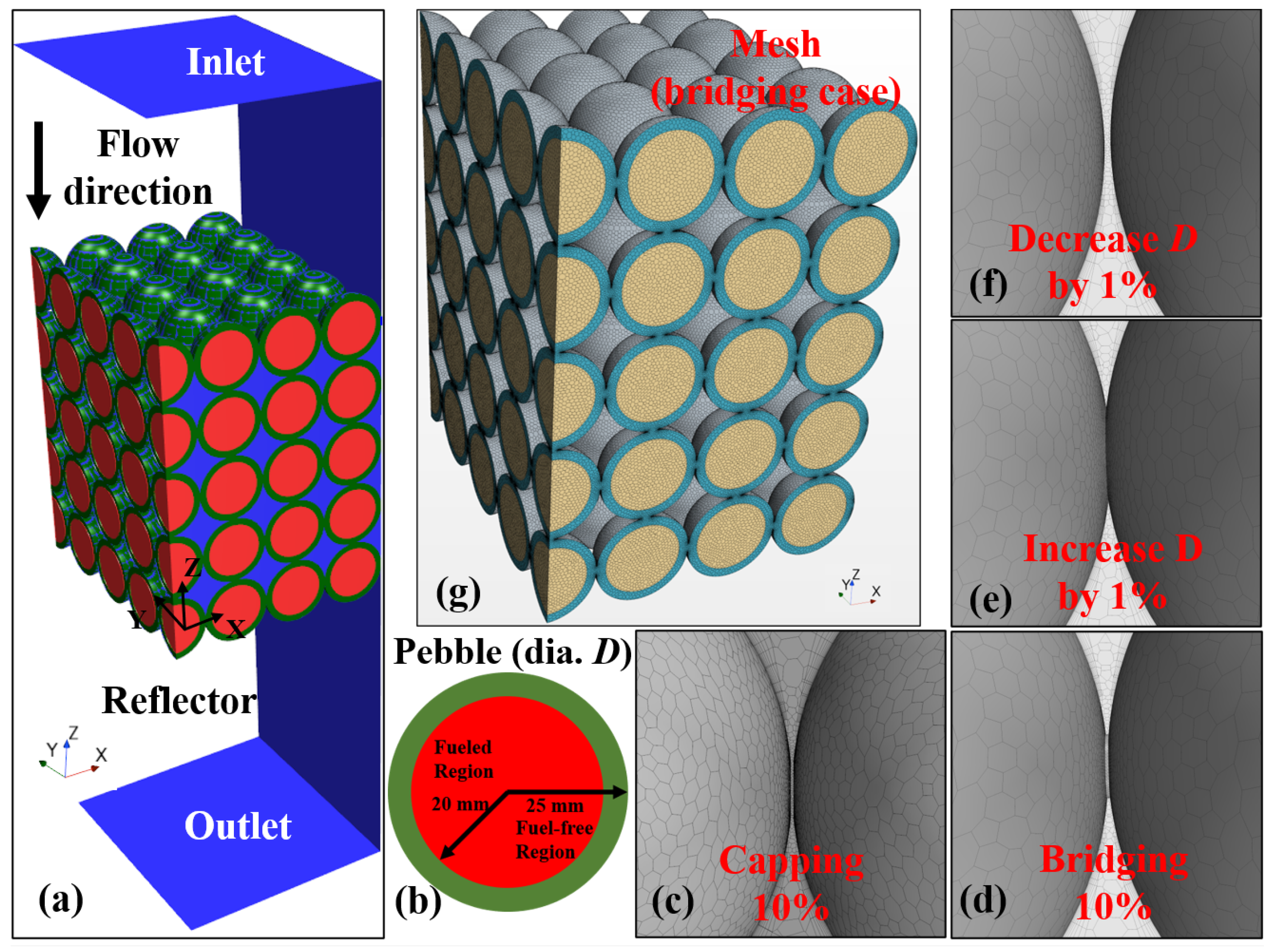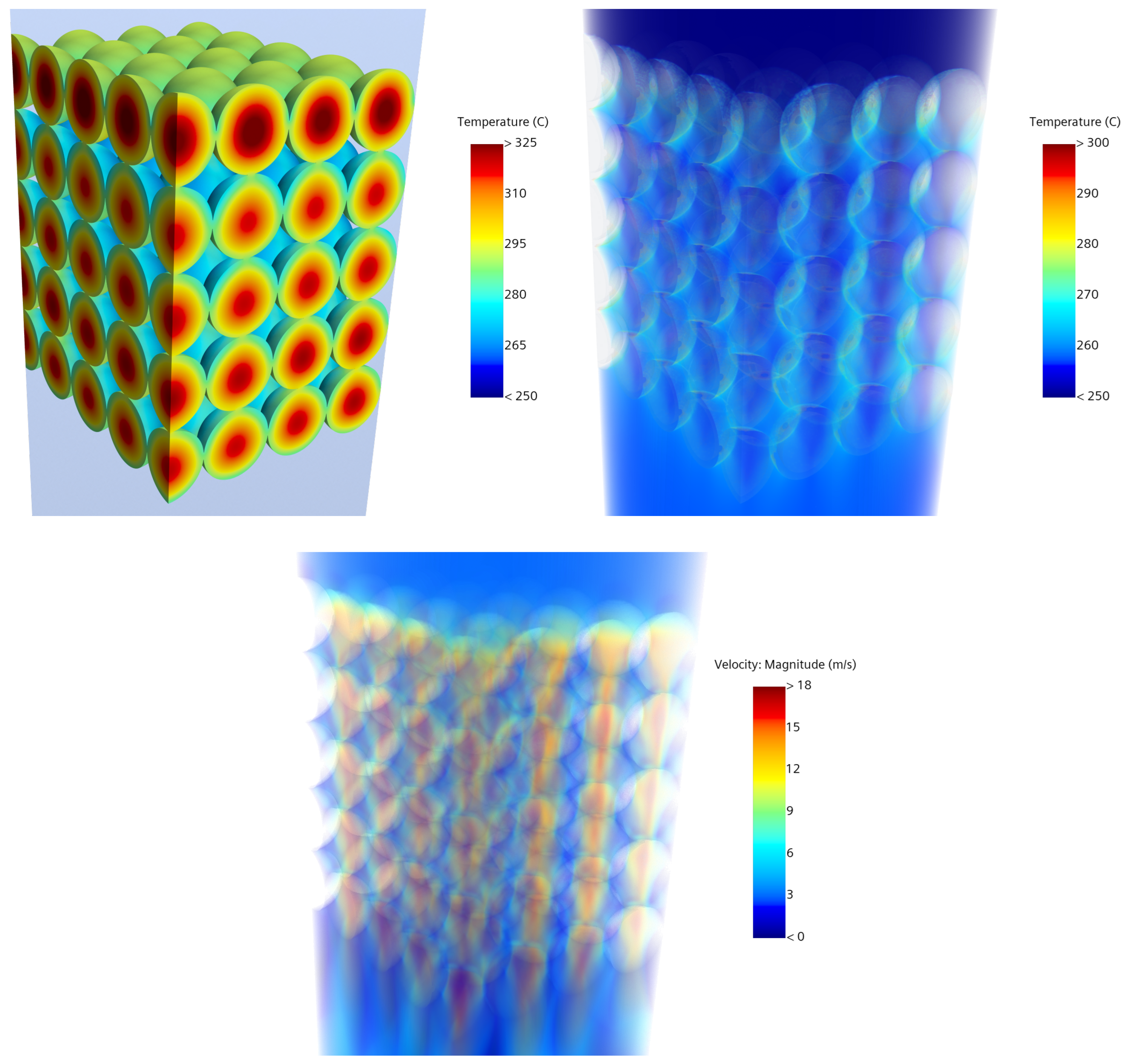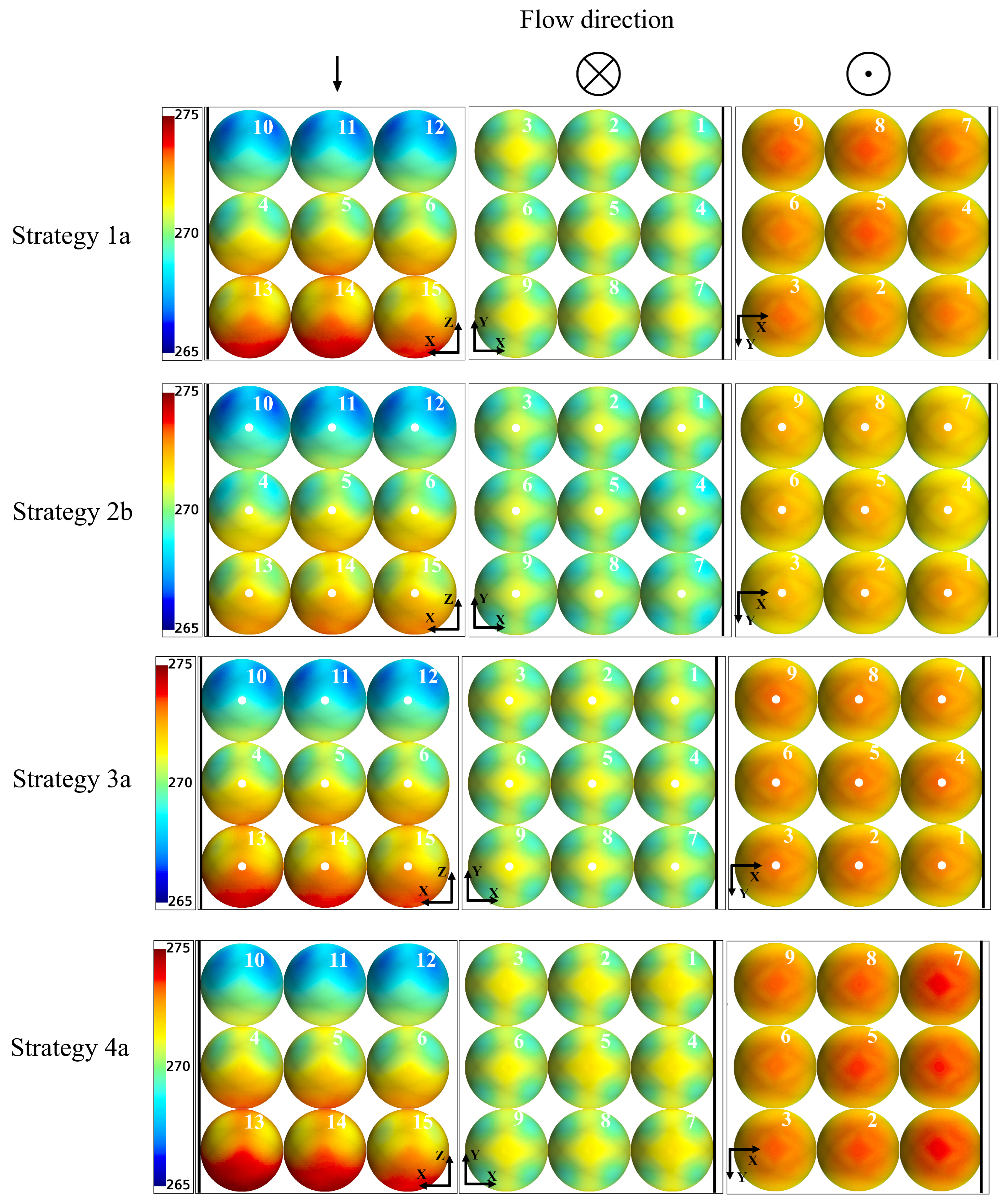Investigation of Point-Contact Strategies for CFD Simulations of Pebble-Bed Reactor Cores
Abstract
1. Introduction
- Strategy 1 (a-b-c): Decreasing the pebble diameter by , , and . This is a simple model-building approach of slightly decreasing the pebble diameter. Decreasing the pebble by was the most computationally expensive approach due to the very small gaps between the pebbles.
- Strategy 2 (a-b-c): Increasing the pebble diameter by , , and .
- Strategy 3 (a-b-c): Bridging—that is, chamfering contact pebbles with a given diameter (, , and in this study) and filling the volume with pebble material. This approach was considered the most similar to the true bed configuration when comparing its porosity to the true value, and thus it was selected as the baseline for comparison.
- Strategy 4 (a-b-c): Capping—that is, chamfering contact pebbles with a given diameter (, , and in this study).
2. Materials and Methods
2.1. Numerical Domain and Material Properties
2.2. Numerical Solvers
- Enabling the standard k- cubic constitutive relationship to improve anisotopic turbulence prediction of secondary flows and streamline curvature [19].
- Each pebble surface mesh face was used in the view factor calculation;
- Gray radiation with no wavelength dependence;
- Diffuse radiation with no angular emission dependence;
- The effective radiation temperature of the environment was specified as 250 °C;
- A pebble surface emissivity of 0.8; and
- Satisfaction of Kirchhoff’s Law, such that emissivity + reflectivity + transmissivity = 1. This forces the surface reflectivity to 0.2 because the transmissivity is 0.
2.3. Mesh Sensitivity
- Volume-averaged pebble fuel temperature, ;
- Maximum pebble fuel temperature, ;
- Volume-averaged fluid temperature, ;
- Volume-averaged fluid velocity magnitude, ;
- Maximum fluid velocity magnitude, ;
- Surface-averaged fluid temperature on plane Z2 (z = 0.1 m), ;
- Surface-averaged fluid velocity magnitude on plane Z2 (z = 0.1 m), ;
- The pressure drop across the entire bed, .
3. Results
3.1. Case 1: Full Power
3.2. Case 2: PLOFC
4. Discussion
Author Contributions
Funding
Institutional Review Board Statement
Informed Consent Statement
Data Availability Statement
Acknowledgments
Conflicts of Interest
Abbreviations
| CFD | computational fluid dynamics. |
| DNS | direct numerical simulation. |
| FCC | face-centered cubic. |
| HALEU | high-assay low-enriched uranium. |
| LES | large-eddy simulation. |
| PIV | particle image velocimetry. |
| PLOFC | pressurized loss of forced cooling. |
| QOI | quantity of interest. |
| QOIs | quantities of interest. |
| RANS | Reynolds-averaged Navier–Stokes. |
| RMS | root mean square. |
| TRISO | tristructural isotropic. |
| URANS | Unsteady Reynolds-averaged Navier–Stokes. |
References
- Dixon, A.G.; Nijemeisland, M.; Stitt, E.H. Systematic mesh development for 3D CFD simulation of fixed beds: Contact points study. Comput. Chem. Eng. 2013, 48, 135–153. [Google Scholar] [CrossRef]
- Nijemeisland, M.; Dixon, A.G. CFD study of fluid flow and wall heat transfer in a fixed bed of spheres. AIChE J. 2004, 50, 906–921. [Google Scholar] [CrossRef]
- Shams, A.; Roelofs, F.; Komen, E.M.J.; Baglietto, E. Optimization of a Pebble Bed Configuration for Quasi-Direct Numerical Simulation. Nucl. Eng. Des. 2012, 242, 331–340. [Google Scholar] [CrossRef]
- Merzari, E.; Yuan, H.; Min, M.; Shaver, D.; Rahaman, R.; Shriwise, P.; Shriwise, P.; Talamo, A.; Lan, Y.; Gaston, D.; et al. Cardinal: A Lower Length-Scale Multiphysics Simulator for Pebble-Bed Reactors. Nucl. Technol. 2021, 27, 1118–1141. [Google Scholar] [CrossRef]
- Yildiz, M.A.; Botha, G.; Yuan, H.; Merzari, E.; Kurwitz, R.C.; Hassan, Y.A. Direct Numerical Simulation of the Flow through a Randomly Packed Pebble Bed. J. Fluids Eng. 2020, 142, 041405. [Google Scholar] [CrossRef]
- Dixon, A.G.; Walls, G.; Stanness, H.; Nijemeisland, M.; Stitt, E.H. Experimental validation of high Reynolds number CFD simulations of heat transfer in a pilot-scale fixed bed tube. Chem. Eng. J. 2012, 200, 344–356. [Google Scholar] [CrossRef]
- Guardo, A.; Coussirat, M.; Larrayoz, M.A.; Recasens, F.; Egusquiza, E. CFD flow and heat transfer in nonregular packings for fixed bed equipment design. Ind. Eng. Chem. Res. 2004, 43, 7049–7056. [Google Scholar] [CrossRef]
- Guardo, A.; Coussirat, M.; Recasens, F.; Larrayoz, M.; Escaler, X. CFD study on particle-to-fluid heat transfer in fixed bed reactors: Convective heat transfer at low and high pressure. Chem. Eng. Sci. 2006, 61, 4341–4353. [Google Scholar] [CrossRef]
- Agency, I.A.E. High Temperature Gas Cooled Reactor Fuels and Materials; International Atomic Energy Agency: Vienna, Austria, 2010. [Google Scholar]
- Boer, B.; Lathouwers, D.; Ding, M.; Kloosterman, J.L. Coupled Neutronics/Thermal Hydraulics Calculations for High Temperature Reactors with the DALTON-THERMIX Code System. In Proceedings of the of PHYSOR, Interlaken, Switzerland, 14–19 September 2008. [Google Scholar]
- Huning, A.J.; Chandrasekaran, S.; Garimella, S. A review of recent advances in HTGR CFD and thermal fluid analysis. Nucl. Eng. Des. 2021, 373, 111013. [Google Scholar] [CrossRef]
- Avramenko, A.; Dmitrenko, N.; Shevchuk, I.; Tyrinov, A.; Kovetskaya, M. Heat transfer and fluid flow of helium coolant in a model of the core zone of a pebble-bed nuclear reactor. Nucl. Eng. Des. 2021, 377, 111148. [Google Scholar] [CrossRef]
- Dixon, A.G.; Ertan Taskin, M.; Nijemeisland, M.; Stitt, E.H. Systematic mesh development for 3D CFD simulation of fixed beds: Single sphere study. Comput. Chem. Eng. 2011, 35, 1171–1185. [Google Scholar] [CrossRef]
- Shams, A.; Roelofs, F.; Komen, E.; Baglietto, E. Numerical simulation of nuclear pebble bed configurations. Nucl. Eng. Des. 2015, 290, 51–64. [Google Scholar] [CrossRef]
- Shams, A.; Roelofs, F.; Komen, E.; Baglietto, E. Numerical simulations of a pebble bed configuration using hybrid (RANS–LES) methods. Nucl. Eng. Des. 2013, 261, 201–211. [Google Scholar] [CrossRef]
- Shams, A.; Roelofs, F.; Komen, E.M.J.; Baglietto, E. Quasi-Direct Numerical Simulation of a Pebble Bed Configuration. Part I: Flow (Velocity) Field Analysis. Nucl. Eng. Des. 2013, 263, 473–489. [Google Scholar] [CrossRef]
- Hassan, Y.A.; Dominguez-Ontiveros, E. Flow visualization in a pebble bed reactor experiment using PIV and refractive index matching techniques. Nucl. Eng. Des. 2008, 238, 3080–3085. [Google Scholar] [CrossRef]
- Nguyen, T.; Muyshondt, R.; Hassan, Y.; Anand, N. Experimental investigation of cross flow mixing in a randomly packed bed and streamwise vortex characteristics using particle image velocimetry and proper orthogonal decomposition analysis. Phys. Fluids 2019, 31, 025101. [Google Scholar] [CrossRef]
- Lien, F.S. Low-Reynolds-number eddy-viscosity modelling based on non-linear stress-strain/vorticity relations. In Proceedings of the 3rd Symposium on Engineering Turbulence Modelling and Measurements, Heraklion-Crete, Greece, 27–29 May 1996; pp. 1–10. [Google Scholar]
- Wallin, S.; Johansson, A.V. An explicit algebraic Reynolds stress model for incompressible and compressible turbulent flows. J. Fluid Mech. 2000, 403, 89–132. [Google Scholar] [CrossRef]
- Hellsten, A. New advanced kw turbulence model for high-lift aerodynamics. AIAA J. 2005, 43, 1857–1869. [Google Scholar] [CrossRef]
- Shih, T.H.; Liou, W.W.; Shabbir, A.; Yang, Z.; Zhu, J. A new k-epsilon eddy viscosity model for high reynolds number turbulent flows. Comput. Fluids 1995, 24, 227–238. [Google Scholar] [CrossRef]
- Siemens. Simcenter STAR-CCM+ User Guide v. 16.02.009; Siemens: Munich, Germany, 2021. [Google Scholar]
- Reynolds, O. IV. On the dynamical theory of incompressible viscous fluids and the determination of the criterion. In Philosophical Transactions of the Royal Society of London.(a.); Royal Society Publishing: London, UK, 1895; pp. 123–164. [Google Scholar]
- Celik, I.B.; Ghia, U.; Roache, P.J.; Freitas, C.J. Procedure for Estimation and Reporting of Uncertainty Due to Discretization in CFD Applications. J. Fluids Eng. 2008, 130, 078001. [Google Scholar]







| Strategies | Pebble Volume [ m3] | Calculated Porosity | [m] | Porosity Error [%] |
|---|---|---|---|---|
| 1a—Decrease | 4.5678 | 0.4780 | 0.0458 | 0.3284 |
| 1b—Decrease | 4.4979 | 0.4860 | 0.0473 | 2.0051 |
| 1c—Decrease | 4.4454 | 0.4920 | 0.0484 | 3.2647 |
| 2a—Increase 0.1% | N/A | N/A | N/A | N/A |
| 2b—Increase 0.5% | 4.6501 | 0.4686 | 0.0441 | −1.6459 |
| 2c—Increase 1.0% | 4.7184 | 0.4608 | 0.0427 | −3.2844 |
| 3a—Bridge 10% | 4.5820 | 0.4763 | 0.0455 | −0.0123 |
| 3b—Bridge 15% | 4.5839 | 0.4761 | 0.0454 | −0.0578 |
| 3c—Bridge 20% | 4.5892 | 0.4755 | 0.0453 | −0.1850 |
| 4a—Cap 10% | 4.5802 | 0.4766 | 0.0455 | 0.0309 |
| 4b—Cap 15% | 4.5790 | 0.4767 | 0.0455 | 0.0597 |
| 4c—Cap 20% | 4.5737 | 0.4773 | 0.0457 | 0.1869 |
| True | 4.5815 | 0.4764 | 0.0455 |
| Region | Boundary | Condition | Value |
|---|---|---|---|
| Pebble fuel region | symmetry | symmetry plane | N/A |
| fuel to fuel-free | contact interface | conformal conduction | |
| Pebble fuel-free region | symmetry | symmetry plane | N/A |
| fuel-free to fuel | contact interface | conformal conduction | |
| fuel-free to fluid | contact interface | conformal convection | |
| fuel-free to reflector | temperature | 250 °C | |
| Heat transport fluid | symmetry | symmetry plane | N/A |
| inlet | inlet velocity 1 | −3 ms−1 | |
| inlet temperature | 250 °C | ||
| turbulence intensity | 0.01 | ||
| turbulent viscosity ratio | 10 | ||
| outlet | outlet pressure | Pa | |
| fluid to reflector | temperature | 250 °C | |
| fluid to fuel-free | contact interface | conformal convection |
| Material Property | Pebble Fuel Region | Pebble Fuel-Free Region | Heat Transport Fluid |
|---|---|---|---|
| Density (kgm−3) | 1700 | 1700 | Ideal gas |
| Specific heat (Jkg−1K−1) | 700 | 700 | 5200 |
| Thermal conductivity (Wm−1K−1) | 25 | 25 | 0.155 |
| Dynamic viscosity () | N/A | N/A | |
| Molecular weight (kgkmol−1) | N/A | N/A | 4.00 |
| Turbulent Prandtl number [12] | N/A | N/A | 0.7 |
| Strategies | Porosity Error [%] | ΔP | ||||
|---|---|---|---|---|---|---|
| 1a—Decrease 0.1% | 0.3284 | −0.3 | −0.4 | −0.1 | 0.0 | 0.0 |
| 1b—Decrease 0.5% | 2.0051 | −22.4 | −4.3 | 0.2 | 0.2 | 0.0 |
| 1c—Decrease 1% | 3.2647 | −33.0 | −7.3 | 0.3 | −0.1 | 0.0 |
| 2a—Increase 0.1% | N/A | N/A | N/A | N/A | N/A | N/A |
| 2b—Increase 0.5% | −1.6459 | 12.4 | 2.8 | 0.2 | 0.0 | 0.0 |
| 2c—Increase 1% | −3.2844 | 21.1 | 5.1 | 0.2 | 0.0 | 0.0 |
| 3a—Bridge 10% | −0.0123 | 0.0 | 0.0 | 0.0 | 0.0 | 0.0 |
| 3b—Bridge 15% | −0.0578 | 1.8 | −0.2 | 0.2 | 0.1 | 0.0 |
| 3c—Bridge 20% | −0.1850 | 3.1 | 0.5 | 0.6 | 0.3 | 0.0 |
| 4a—Cap 10% | 0.0309 | −13.1 | −1.9 | 0.0 | 0.0 | −0.1 |
| 4b—Cap 15% | 0.0597 | −22.8 | −3.6 | 0.2 | −0.4 | 0.0 |
| 4c—Cap 20% | 0.1869 | −27.3 | −4.4 | −0.4 | −0.3 | 0.0 |
| GCI (%)—Bridge 10% | N/A | 3 | 0.1 | 3.4 | 0.6 | 0.1 |
| Strategy | Case 2a | Case 2b | ||||
|---|---|---|---|---|---|---|
| 1a—Decrease | 13.8 | 6.5 | 5.8 | 1.4 | 0.7 | 0.2 |
| 1b—Decrease | 20.2 | 9.7 | 8.9 | 1.6 | 0.7 | 0.4 |
| 1c—Decrease | 25 | 12.1 | 11.5 | 1.5 | 0.7 | 0.6 |
| 2a—Increase 0.1% | N/A | N/A | N/A | N/A | N/A | N/A |
| 2b—Increase 0.5% | −1.5 | −0.9 | −1.2 | 0 | 0 | −0.2 |
| 2c—Increase 1.0% | −4.3 | −2.5 | −3.1 | −0.6 | −0.2 | −0.4 |
| 3a—Bridge 10% | 0.0 | 0.0 | 0.0 | 0.0 | 0.0 | 0.0 |
| 3b—Bridge 15% | −2.9 | −1.4 | −1.2 | −0.7 | −0.3 | −0.1 |
| 3c—Bridge 20% | −4.7 | −2.3 | −2 | −1.3 | −0.6 | −0.2 |
| 4a—Cap 10% | 15.6 | 7.8 | 8.1 | 0.5 | −0.5 | −1.3 |
| 4b—Cap 15% | 19.6 | 9.6 | 9.7 | 0.6 | −0.5 | −1.3 |
| 4c—Cap 20% | 22.8 | 11.1 | 11.1 | 0.8 | −0.4 | −1.2 |
| Strategies | |||||
|---|---|---|---|---|---|
| 1a—Decrease 0.1% | −1.2 | −0.4 | 0.0 | 0.0 | 0.0 |
| 1b—Decrease 0.5% | −8.6 | −2.3 | 0.1 | 0.0 | 0.0 |
| 1c—Decrease 1% | −19.1 | −5.1 | 0.2 | 0.1 | 0.0 |
| 2a—Increase 0.1% | N/A | N/A | N/A | N/A | N/A |
| 2b—Increase 0.5% | 9.8 | 2.3 | −0.1 | −0.1 | 0.0 |
| 2c—Increase 1% | 18.4 | 4.4 | −0.1 | −0.2 | 0.0 |
| 3a—Bridge 10% | 0.0 | 0.0 | 0.0 | 0.0 | 0.0 |
| 3b—Bridge 15% | −0.4 | 0.2 | 0.0 | 0.0 | 0.0 |
| 3c—Bridge 20% | −0.9 | 0.5 | 0.0 | 0.1 | 0.0 |
| 4a—Cap 10% | −0.5 | 0.0 | 0.3 | 0.2 | 0.0 |
| 4b—Cap 15% | −2.3 | −0.5 | 0.3 | 0.1 | 0.0 |
| 4c—Cap 20% | −7.2 | −3.4 | 0.6 | −0.1 | 0.0 |
Disclaimer/Publisher’s Note: The statements, opinions and data contained in all publications are solely those of the individual author(s) and contributor(s) and not of MDPI and/or the editor(s). MDPI and/or the editor(s) disclaim responsibility for any injury to people or property resulting from any ideas, methods, instructions or products referred to in the content. |
© 2024 by the authors. Licensee MDPI, Basel, Switzerland. This article is an open access article distributed under the terms and conditions of the Creative Commons Attribution (CC BY) license (https://creativecommons.org/licenses/by/4.0/).
Share and Cite
Goth, N.; Nguyen, T.; Pointer, W.D. Investigation of Point-Contact Strategies for CFD Simulations of Pebble-Bed Reactor Cores. Appl. Sci. 2024, 14, 7343. https://doi.org/10.3390/app14167343
Goth N, Nguyen T, Pointer WD. Investigation of Point-Contact Strategies for CFD Simulations of Pebble-Bed Reactor Cores. Applied Sciences. 2024; 14(16):7343. https://doi.org/10.3390/app14167343
Chicago/Turabian StyleGoth, Nolan, Thien Nguyen, and William David Pointer. 2024. "Investigation of Point-Contact Strategies for CFD Simulations of Pebble-Bed Reactor Cores" Applied Sciences 14, no. 16: 7343. https://doi.org/10.3390/app14167343
APA StyleGoth, N., Nguyen, T., & Pointer, W. D. (2024). Investigation of Point-Contact Strategies for CFD Simulations of Pebble-Bed Reactor Cores. Applied Sciences, 14(16), 7343. https://doi.org/10.3390/app14167343






